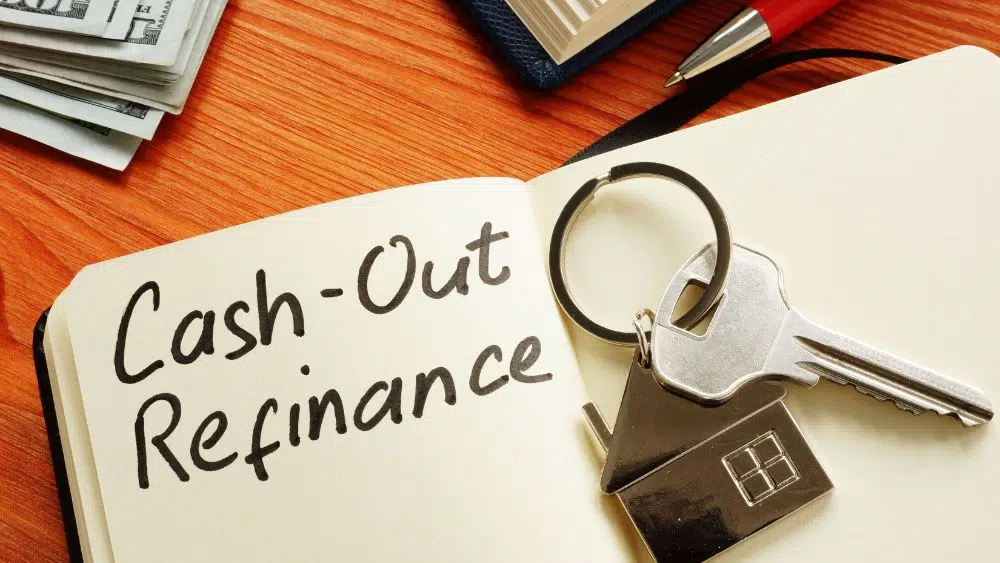If you’re a cash-strapped homeowner with a solid chunk of home equity in your name, cash-out refinancing is an option worth considering if you need a lump sum of money.
In a nutshell, a cash-out refi is a type of mortgage refinancing that replaces your existing mortgage with a new higher amount. You’ll pay off your existing mortgage under the new loan’s terms, and you’ll get a chunk of change to consolidate debts, pay for a major home renovation, or cover any other major expenses. In turn, however, you’ll have a new mortgage, interest rate, and monthly payment to deal with.
Cash-out refinancing isn’t for everyone, and it’s just one of many ways homeowners can leverage their home equity to access funds when they need it.
If you’re considering a cash-out refinancing, here’s everything you need to know about how they work and how to apply for one.

What is Cash-Out Refinancing?
Essentially, a cash-out refinance replaces your existing mortgage with a brand new one that comes with a new loan amount, interest rate, terms, and monthly payment.
The cash-out refi will be larger than the balance on your existing mortgage, giving you enough funds to pay it off and provide you with an extra lump sum of cash.
In short, you’re turning a portion of the home equity you’ve established over the years into a cash payout. Typically, lenders allow homeowners to borrow up to 80 percent of their home’s market value.
Say, for example, your home is appraised at $200,000 and you still owe $100,000 on your current mortgage. You may be approved for a cash-out refinance of $160,000. You’ll use the first $100,000 to clear your current mortgage, leaving you with $60,000 in your bank account.
How Does Cash-Out Refinancing Work?
For starters, you’ll need to find a lender that provides cash-out refinancing, and they don’t necessarily have to be the same lender as the one that issued your initial mortgage.
The lender will assess your current mortgage’s terms, your home’s appraised value, how much equity you’ve established, and how much you owe. But they’ll also take stock of factors like your credit score, monthly income, and debt-to-income ratio to see if you can manage a new mortgage and, potentially, higher monthly payments.
From there, they’ll set up a new loan with new terms you’ll be locked in for – one that’s enough to pay off your initial mortgage and provide you with the cash you need. Once your existing mortgage balance is cleared, the rest is paid to you in a lump sum.
As a general rule of thumb, lenders will require that you maintain at least 20 percent of the equity in your home, but this will vary from lender to lender and your initial loan type. If your original mortgage was a Veterans Affairs home loan, for example, you may be eligible to use 100 percent of your home equity under the VA cash-out refinancing program.

What Can I Use a Cash-Out Refi For?
You can use the funds from a cash-out refi on virtually anything you want. But for practical purposes, the wisest ways to use a cash-out refi include:
- To pay for home improvement projects. Most homeowners tap into the home equity to pay for a kitchen renovation, replacing the roof or HVAC system, or constructing an extension to the property. This way, their cash-out refi is helping to build more property value. Bonus: If you’re using your cash-out refi income on “capital home improvement” projects, your mortgage interest is tax-deductible!
- To secure a lower interest rate. Some homeowners opt for a cash-out refi simply to re-establish a new home loan, to either secure a lower interest rate, or select longer terms. In both cases, this would lead to lower monthly payments. If the interest rates have dropped or your financial situation has improved (higher credit score, more income, fewer debts), you could be in a prime position to score a lower interest rate.
- To consolidate debts. If you’re grappling with credit card debt or payday loans, with interest rates of 19.99 percent up to as high as 46.96 percent, you may decide to apply for a cash-out refi to wipe these debts clean. Your new mortgage’s interest rate won’t be nearly as high.
- To pay for emergency expenses. Sometimes home equity can be a saving grace if you need to tap into it to pay for unforeseen costs like medical expenses or car repairs – or if you have become unemployed.
Ultimately, you’re trading away your hard-earned home equity so you shouldn’t waste the proceeds of your cash-out refi on frivolous spending.
How Much Will a Cash-Out Refi Cost me?
Cashing out a portion of your home equity comes at a price: Expect to pay between two and five percent of your new loan amount on closing costs. The amount is deducted directly from the “cash-out” you’ll receive. It includes everything from loan origination fees, appraisals and inspections on your property, credit report checks, a title examination, and any other administrative work involved in the underwriting and setting up of your new loan.
How much you end up paying in closing costs may be the dealbreaker that stops you from proceeding with a refinancing. If, for example, you only need $10,000 but your closing costs total half of that or more, it may not be worthwhile.
If you’re about to do this, do your homework and comparison shop between lenders. Some may offer “no-cost refinancing,” which means the loan they’d issue you rolls the closing costs into the total balance you’d owe. In other cases, they’ll provide no-cost refinancing in exchange for a higher interest rate.
It’s worth noting that both home equity loans and home equity lines of credit (HELOC) come with closing costs, too.
What is the Interest Rate on a Cash-Out Refi?
Cash-out refinancing is available with a fixed- or variable-rate mortgage. Which route you take will depend on your personal preferences and what options your lender provides.
With a fixed interest rate, your rate is locked in for the entirety of your loan, and you’ll know precisely how much you’ll need to pay each month, which is ideal for budgeting. With a variable interest rate, your rate could drop lower than what’s on offer with a fixed rate – and, in turn, your repayments will fluctuate from month to month.
What are the Disadvantages of a Cash-Out Refinance?
You need to think carefully anytime you put your home equity on the line or you commit to shouldering more debt. Here are the key red flags to pay attention to with cash-out refis:
- You’re taking out a larger loan against your home. Despite securing a lower interest rate or freeing up cash to pay for other necessities, you’re agreeing to trade away your home equity and take on more debt. This means you could be drawing out the life of your mortgage. If your payments are higher, you’re also putting a strain on your budget.
- You’re borrowing at a premium. Keep in mind you’ll have to pay for closing costs when going through the cash-out refi application process. If your home equity dips to below 20 percent, you’ll have to pay for private mortgage insurance – or PMI – too. This insurance protects lenders in case you default on your loan.
- You’re using your home as collateral. Sometimes a cash-out refi isn’t the best idea, especially if you’re straining your budget. If things go awry and you default on your loan, you may be putting your family’s home at risk.
- You may be living life outside your means. While cash-out refis are a convenient way to qualify for a loan, homeowners need to tread carefully to decipher if the financing is for a want or a need. In some cases, a cash-out refi could be a reckless way to spend hard-earned home equity.
- You must be patient. Between the underwriting process, appraisals, and credit checks, the process to securing a cash-out refinancing can take up to two months. If you need access to funding immediately, it may not be your best bet.

How Do I Qualify for Cash-Out Refinancing?
If you’ve done the number-crunching and decided a cash-out refinance works for your family’s financial needs, here are the typical criteria you’ll need to meet to get approved:
- A minimum credit score of at least 600 to 640. Experian notes that in some cases, you may be able to secure a cash-out refi with a credit score that’s as low as 580 – if you have a low debt-to-income ratio and a steady income to make payments.
- A debt-to-income ratio of less than 50 percent. Your debt-to-income ratio is the percentage of your gross monthly income that goes towards paying your existing debts. Lenders will zero in on this ratio because they will want to know that you’ll have enough income to repay your home equity loan.
- Sufficient home equity that’s more than 20 percent. Keep in mind that for the most part, lenders will insist that you maintain at least 20 percent of the equity in your home. You should have more equity you can cash out to make the refinancing worthwhile.
- Homeownership for at least six months. You can’t apply for a cash-out refinance on conventional home loans – or VA home loans – until you’ve owned the property for at least six months. With FHA loans, this caveat extends to 12 months. You can ask your lender to make exceptions in extreme circumstances, though.
- Successful closing. Getting the green light for a cash-out refi also hinges on various checkpoints in the closing process. Your property must pass an appraisal and come out with a generous market value evaluation, while you’ll need to pass credit checks and the underwriting process.

Carmen Chai is an award-winning Canadian journalist who has lived and reported from major cities such as Vancouver, Toronto, London and Paris. For NewHomeSource, Carmen covers a variety of topics, including insurance, mortgages, and more.
 How Does a Construction Loan Work?
How Does a Construction Loan Work?